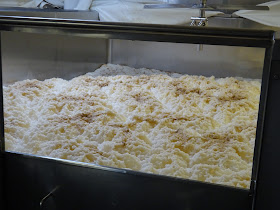Best UK Cask Beer:
Irving and Co. Iron Duke. I did some beer tasting for our Mother Church's strong bitter category at Woking Beer Festival and this was the well deserved winner. Lovely it was.
Best UK Keg Beer:
Always a tricky one this. I definitely have drunk some keg beer this year, but was any of it British? I had a pint of Carlsberg at a friend's anniversary do. Foul it was, but it must have been brewed in Britain. And at a Homebrew event in London they only had beer served from the devil's drainpipe, but one of them was Paulaner and the other was a 12% ABV maple stout that, perhaps unsurprisingly, I can't remember who made it or where but I've a feeling it wasn't British. Oh, and I had to switch to Guinness at a gig, but that's brewed in Ireland. OK, it will have to be the Carlsberg.
Best UK Bottled Beer:
An outstanding bottled beer for me this year was some home brewed Wheeler's Entire Stout I got sent. But as far as commercial beers go I went to great lengths to find Greene King's Heritage Beer, which was great but the winner is Thurstons Time Machine. It's a cracker.
Best UK Canned Beer:
Since the tragic closure of Wine Rack in West Byfleet I've hardly drunk canned beer, but whilst it was open I did get through a few tinnies of Moor Hoppiness.
Best Overseas Draught:
Brewers overseas are overwhelmingly heathens, so draught beer usually comes via the devil's drainpipe. I did manage to have some cask beer when I was in Amsterdam, but it was brewed by a British brewer so I don't think that counts. I'll go for something I drank in Britain though, that 12% ABV maple stout I'm sure was brewed overseas. Very sweet and ludicrously strong it was but still nice.
Best Overseas Bottled Beer:
Rather than revert to my usual of Orval for this let's go with Westmalle Tripel this year as I bought enough bottles of it before having a go at brewing my own version. Mind you, I did the same with Orval so maybe that should be the winner.
Best Overseas Canned Beer:
Can't think of any foreign cans I've had.
Best collaboration brew:
Or collaboration brews for that matter.
Best Overall Beer:
Seeing as it's the pinnacle of the brewers art: Irving and Co. Iron Duke.
Best Branding:
Oh I don't know. Do other people pay more attention to this than me? Let's go with Thurstons as there's another excellent label from Too Much Black Coffee on the Time Machine.
Best UK Brewery:
By rights it should go to Irving and Co. but I only had a pint or two of one of their beers. So instead I'm going to go with a brewery whose beers I'm always delighted to drink and I finally got to visit there this year: Timothy Taylors.
Best Overseas Brewery:
This one will have to be Westmalle.
Best New Brewery Opening 2018:
Can't think of one.
Pub/Bar of the Year:
The Crown of course.
Best New Pub/Bar Opening 2018:
Can't think of one of these either.
Beer Festival of the Year:
Definitely the Carnivale Brettanomyces this year. I had a wonderful time and I even wrote up the talks for the IBD mag.
Supermarket of the Year:
Not bought a lot of beer from supermarkets this year but Tescos had the Greene King Heritage Beer so them.
Independent Retailer of the Year:
Seeing as Wine Rack closed their shop nearest to me they're not winning. So it's Cobbett's Real Ale this year.
Online Retailer of the Year:
Don't think I've bought any beer online this year.
Best Beer Book or Magazine:
The best magazine remains the IBD one. I look forward to it each month. A book released this year saw me become a published photographer though so the clear winner is CAMRA's Essential Home Brewing. I really should get round to writing up my thoughts on it...
Best Beer Blog or Website:
Last year I discovered the wonderful world of blogs by people ticking off the entire Good Beer Guide. Clearly it's an almost impossible task but that should never stop you starting anything. The intrepid travels around the country (despite his dodgy knee he doesn't like to talk about), drinking in pubs and being rude about the locals make the British Real Ale Pub Adventure this year's winner.
Simon Johnson Award for Best Beer Twitterer:
Another tricky one this but I actually met @Ramblin_Dave thanks to twitter and he gave me some lovely Bretty beer so him.
Now what can I add...Best Podcast should really be added to the list and for me that's the MBAA, and I normally like to use the opportunity of Golden Pints to take the piss out of someone but Pete Brown's short temper got a mention in my last post so I'll leave it at that.























































